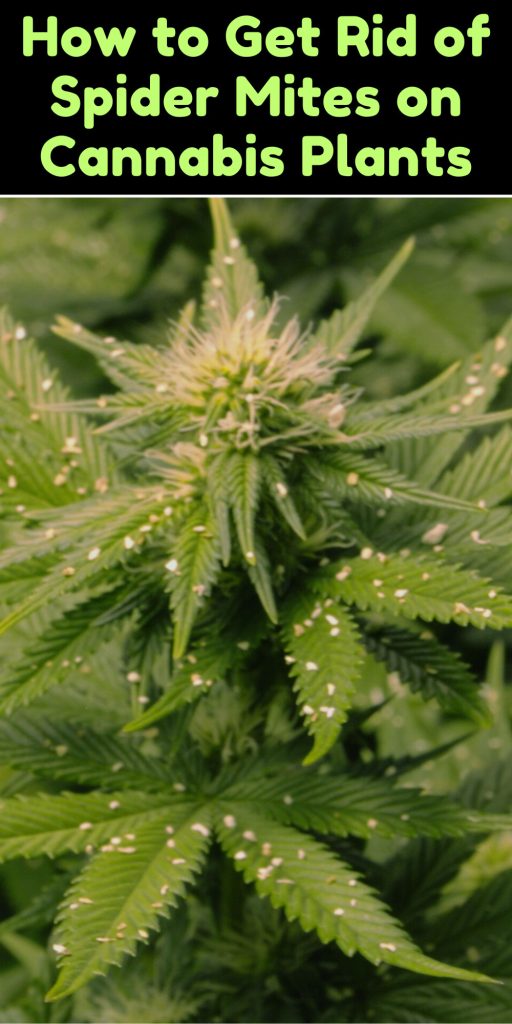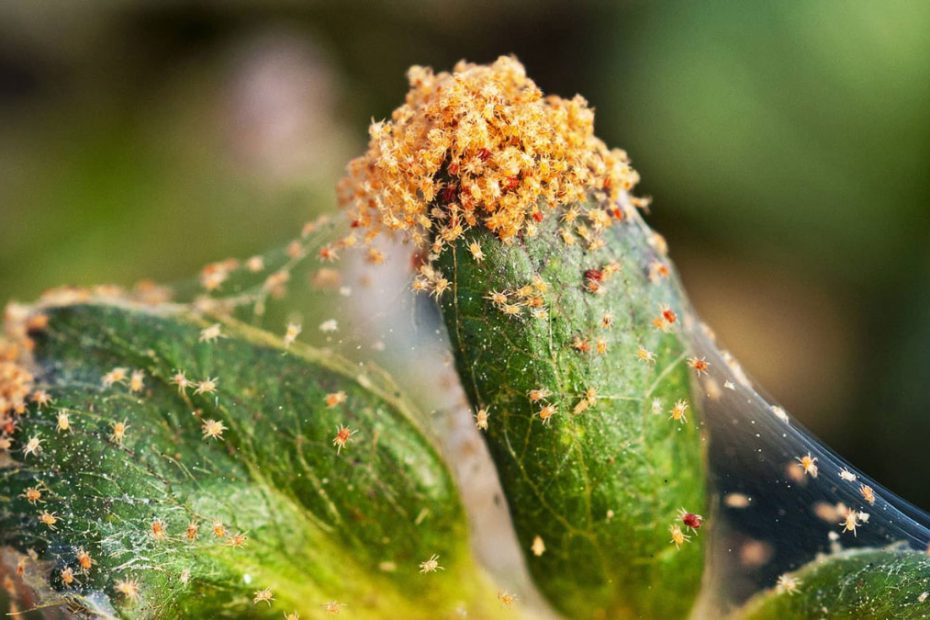Spider mites can wreak havoc on your cannabis plants, turning a promising grow into a gardener’s nightmare. These tiny pests suck the life out of your plants, leaving behind discolored leaves and weakened stems. If left unchecked, they can decimate your entire crop.
But don’t worry, getting rid of spider mites is entirely possible with the right approach. In this guide, you’ll learn effective methods to identify, control, and eliminate these persistent pests. Say goodbye to spider mites and hello to healthy, thriving cannabis plants.
Key Takeaways
- Identify Early Signs: Look for white or yellow speckles on leaves, fine webbing, and discoloration. Use a magnifying glass to spot tiny red or yellow mites.
- Natural Remedies: Employ beneficial predators like ladybugs and predatory mites, or use homemade sprays such as neem oil, soap solutions, and garlic/chili pepper mix for eco-friendly control.
- Chemical Treatments: Use insecticidal soaps and miticides for severe infestations, ensuring proper application and safety per product guidelines.
- Preventive Measures: Maintain plant health through cleanliness, regular inspections, pruning, and consistent watering. Adjust environmental factors like humidity, temperature, and airflow to deter spider mites.
- Regular Monitoring: Frequent plant inspections and the use of sticky traps help detect infestations early, allowing for prompt action.

Understanding Spider Mites
What Are Spider Mites?
Spider mites are tiny arachnids that measure about 0.4 mm. They thrive in warm, dry conditions, making them common in indoor cannabis cultivations. Even though their small size, spider mites can be spotted with the naked eye, particularly when infestations grow. These pests typically appear as small red or yellow dots on the underside of leaves.
Key Characteristics of Spider Mites:
- Size: Approximately 0.4 mm
- Color: Often red or yellow
- Habitat: Prefer warm and dry environments
- Behavior: Spin webbing on the underside of leaves
Why Are Spider Mites Harmful to Cannabis Plants?
Spider mites cause damage by piercing the plant’s cells and sucking out the contents. This disrupts the plant’s ability to photosynthesize, leading to poor growth and diminished yields. Infested leaves often display white or yellow speckles that eventually turn into webbed areas, signaling severe infestation.
- Nutrient Sucking: Draw essential nutrients from leaves
- Photosynthesis Disruption: Hinders the plant’s growth abilities
- Visible Damage: Leaves show speckles and webbing
- Yield Reduction: Lower overall plant productivity
Spider mites not only affect the current crop but can also reduce the overall vitality of your plants, making them more susceptible to other pests and diseases. It’s crucial to address infestations promptly to maintain plant health and productivity.
Identifying Spider Mite Infestations
Detecting spider mites early is crucial to saving your cannabis plants. You’ll preserve your crop by knowing what signs to look for.
Common Signs of Spider Mites
Recognize an infestation by familiarizing yourself with these common signs:
- Speckled Leaves: Look for white or yellow speckles, primarily on the tops of leaves.
- Webbing: Notice fine webbing on the underside of leaves, often near the plant’s nodes.
- Discoloration: Observe any change in leaf color, including yellowing or browning.
- Mite Visibility: Use a magnifying glass to spot tiny red or yellow mites moving on the leaves.
- Stunted Growth: Identify slowed growth patterns and weak, drooping plants.
How to Properly Inspect Your Cannabis Plants
Thorough inspection helps in early detection and effective control. Follow these steps:
- Begin Regular Checks: Inspect plants daily, especially during warm, dry conditions.
- Examine Leaves: Use a magnifying glass to check the underside of leaves for mites and webbing.
- Look in Hidden Spots: Check nodes and stems since mites often hide in these areas.
- Assess Damage: Identify any speckled, discolored, or drooping leaves.
- Use Sticky Traps: Place them around plants to see if mites are present.
Stay vigilant by routinely monitoring your cannabis plants. Early identification ensures swift action against spider mite infestations.
Natural Remedies for Spider Mites
Addressing spider mites on cannabis plants can be effectively done using natural remedies. These methods provide sustainable and eco-friendly options to manage infestations without relying on harsh chemicals.
Beneficial Predators
Using beneficial predators introduces natural enemies of spider mites into your cannabis cultivation. These predators feed on spider mites, reducing their population significantly.
Key Predators:
- Ladybugs: Feast on both adult mites and their eggs, providing comprehensive control.
- Predatory Mites (Phytoseiulus persimilis and Neoseiulus californicus): Specialize in hunting spider mites and thrive in similar conditions to cannabis plants.
- Lacewing Larvae: Consume a high number of spider mites and other pests, aiding in broad-spectrum pest control.
Implementation Steps:
- Purchase beneficial predators from a reputable supplier.
- Release them on infested plants, targeting areas with visible mite presence.
- Ensure an environment conducive to predator survival, avoiding excessive use of insecticides.
Homemade Sprays
Homemade sprays offer a cost-effective way to combat spider mites using readily available ingredients. These sprays can disrupt mite activity and reproductive cycles.
Effective Spray Ingredients:
- Neem Oil: Works by interfering with the mites’ hormone systems and deterring feeding.
- Soap Solution (2% dish soap): Breaks down mite exoskeletons, leading to dehydration and death.
- Garlic and Chili Pepper Spray: Acts as a repellent, deterring mites from feeding on treated plants.
- Neem Oil Spray:
- Mix 2 tablespoons of neem oil with 1 gallon of water.
- Add a few drops of dish soap to emulsify the mixture.
- Spray the mixture on the affected plants every 7 days until mites are controlled.
- Soap Solution:
- Combine 2 tablespoons of dish soap (without degreasers) with 1 gallon of water.
- Apply the solution to the plant leaves, ensuring coverage on the underside.
- Repeat every 4-7 days as necessary.
- Garlic and Chili Pepper Spray:
- Blend 5 garlic cloves and 5 chili peppers with 1 cup of water.
- Strain the blend and add it to 1 gallon of water with a few drops of dish soap.
- Apply the spray bi-weekly to deter mites and other pests.
Using these natural remedies promotes a healthier growing environment for your cannabis plants. Regular monitoring, combined with these methods, can help in effectively managing spider mite infestations.
Chemical Treatments for Spider Mites
Chemical treatments target spider mites effectively, offering swift control for severe infestations on cannabis plants. While natural remedies are beneficial, chemical methods provide a more direct approach when immediate results are needed.
Insecticidal Soaps
Insecticidal soaps function by penetrating the mite’s outer shell, disrupting cell membranes and leading to dehydration.
Key Features:
- Mode of Action: Targets mites through contact; primarily effective on juvenile stages.
- Application: Spray directly on infested areas, ensuring thorough coverage of leaf undersides.
- Safety: Generally safe for cannabis plants, but avoid use during flowering to prevent residue.
Application Steps:
- Mix insecticidal soap according to the manufacturer’s instructions.
- Use a spray bottle or garden sprayer to apply the solution.
- Focus on the underside of leaves, where mites commonly reside.
- Repeat every 5-7 days until you see no signs of mites.
Miticides
Miticides are specialized chemical agents designed specifically to kill mites.
Key Terminology:
- Active Ingredients: Chemicals such as abamectin, bifenthrin, and spiromesifen specifically target mite physiology.
- Selective Toxicity: Effective against spider mites while minimizing impact on beneficial insects.
Usage Guidelines:
- Read Labels: Follow instructions precisely to avoid over-application and potential plant damage.
- Rotate Miticides: Prevent resistance by alternating between different active ingredients.
- Protective Measures: Wear gloves, eye protection, and a mask during application to ensure personal safety.
- Identification: Confirm spider mite presence through visual inspection or magnification.
- Dilution: Prepare the miticide solution as per instructions.
- Spraying: Apply evenly across the plant, paying extra attention to dense foliage and hidden spots.
- Monitoring: Assess plant health and mite activity post-application, repeating as necessary every 7-10 days.
By utilizing these chemical treatments, you can effectively manage spider mite infestations on cannabis plants. Ensure proper application and safety measures to maintain plant health and achieve optimal results.
Preventive Measures
Implementing preventive measures can protect your cannabis plants from spider mites. Regular plant care and environmental controls are essential components in maintaining a healthy growing environment.
Regular Plant Care
Healthy plants resist spider mites better. Focus your efforts on these key areas:
- Cleanliness: Regularly remove dead leaves and debris from around your plants to reduce hiding spots.
- Inspection: Conduct routine inspections. Look for signs of spider mites on the underside of leaves.
- Pruning: Trim lower branches and leaves to improve air circulation. Well-spaced plants deter spider mite infestations.
- Watering: Maintain consistent watering schedules. Stressed plants attract pests more easily.
Environmental Controls
Creating an inhospitable environment for spider mites can prevent infestations:
- Humidity: Increase humidity levels; spider mites thrive in dry conditions. Aim for 55%-60% relative humidity.
- Temperature: Keep temperatures below 80°F. Spider mites are less active in cooler environments.
- Airflow: Use fans to enhance air circulation, reducing the likelihood of mite colonies.
- Light: Be mindful of lighting schedules. Spider mites prefer continuous light; consider light/dark cycles.
Use these preventive measures to minimize the risk of spider mite infestations, ensuring healthier cannabis plants. Engage in regular monitoring and environmental adjustments to keep your growing area optimal and pest-free.
Conclusion
Dealing with spider mites on cannabis plants requires a proactive approach and a combination of strategies. By staying vigilant with regular inspections and employing both natural and chemical treatments, you can effectively manage and eliminate these pests. Incorporating preventive measures, such as maintaining cleanliness and optimizing environmental conditions, further protects your plants from future infestations. With these methods, you’ll ensure your cannabis plants remain healthy and productive, free from the detrimental effects of spider mites.
Frequently Asked Questions
What are the signs of a spider mite infestation on cannabis plants?
Signs of a spider mite infestation include speckled leaves, fine webbing, discoloration, visible mites on the undersides of leaves, and stunted growth. These symptoms indicate that the mites are damaging the plant by sucking its nutrients.
How can I identify spider mites on my cannabis plants?
Spider mites are tiny red or yellow dots, about 0.4 mm in size, usually found on the undersides of leaves. You might also see webbing they’ve spun. Use a magnifying glass for a closer inspection.
What environmental conditions do spider mites thrive in?
Spider mites thrive in warm, dry conditions, which are often prevalent in indoor cannabis cultivations. Aim for increased humidity and temperatures below 80°F to inhibit their growth.
What natural remedies can I use to control spider mites?
Natural remedies include beneficial predators like ladybugs, predatory mites, and lacewing larvae. Homemade sprays such as neem oil, soap solutions, and garlic and chili pepper sprays can also disrupt mite activity.
Are there chemical treatments for spider mites, and how effective are they?
Yes, chemical treatments like insecticidal soaps and miticides can provide swift control for severe infestations. They work by dehydrating the mites or killing them outright. Always follow usage guidelines to prevent resistance.
How often should I inspect my cannabis plants for spider mites?
Regular inspections are crucial. Conduct checks at least once a week, focusing on the undersides of leaves, hidden spots like nodes and stems, and use sticky traps to monitor for mites.
What preventive measures can I take to avoid spider mite infestations?
Maintain cleanliness by removing dead leaves, ensure consistent watering, prune for better air circulation, and increase humidity. Use fans for better airflow and manage light exposure to create an inhospitable environment for spider mites.
